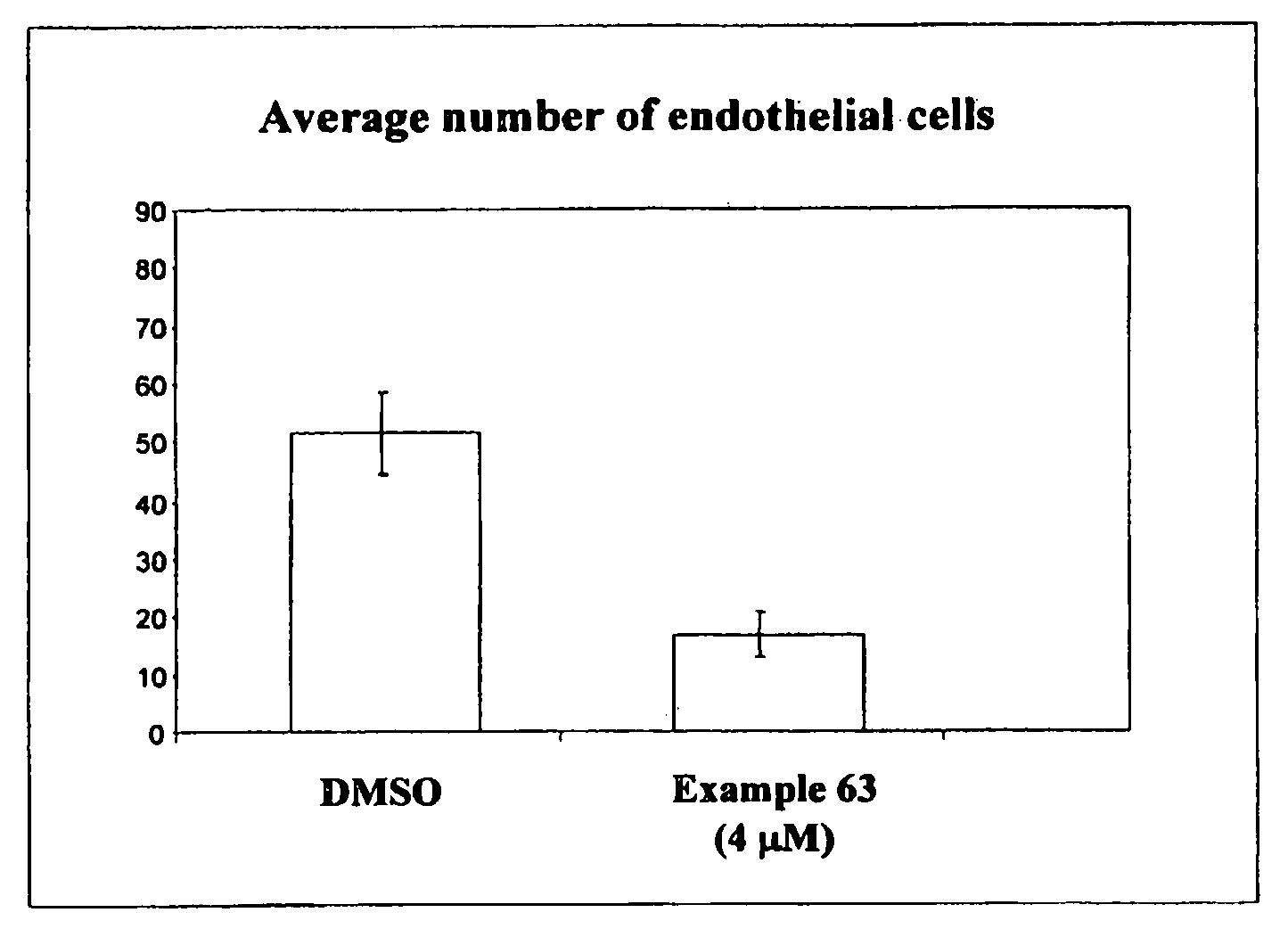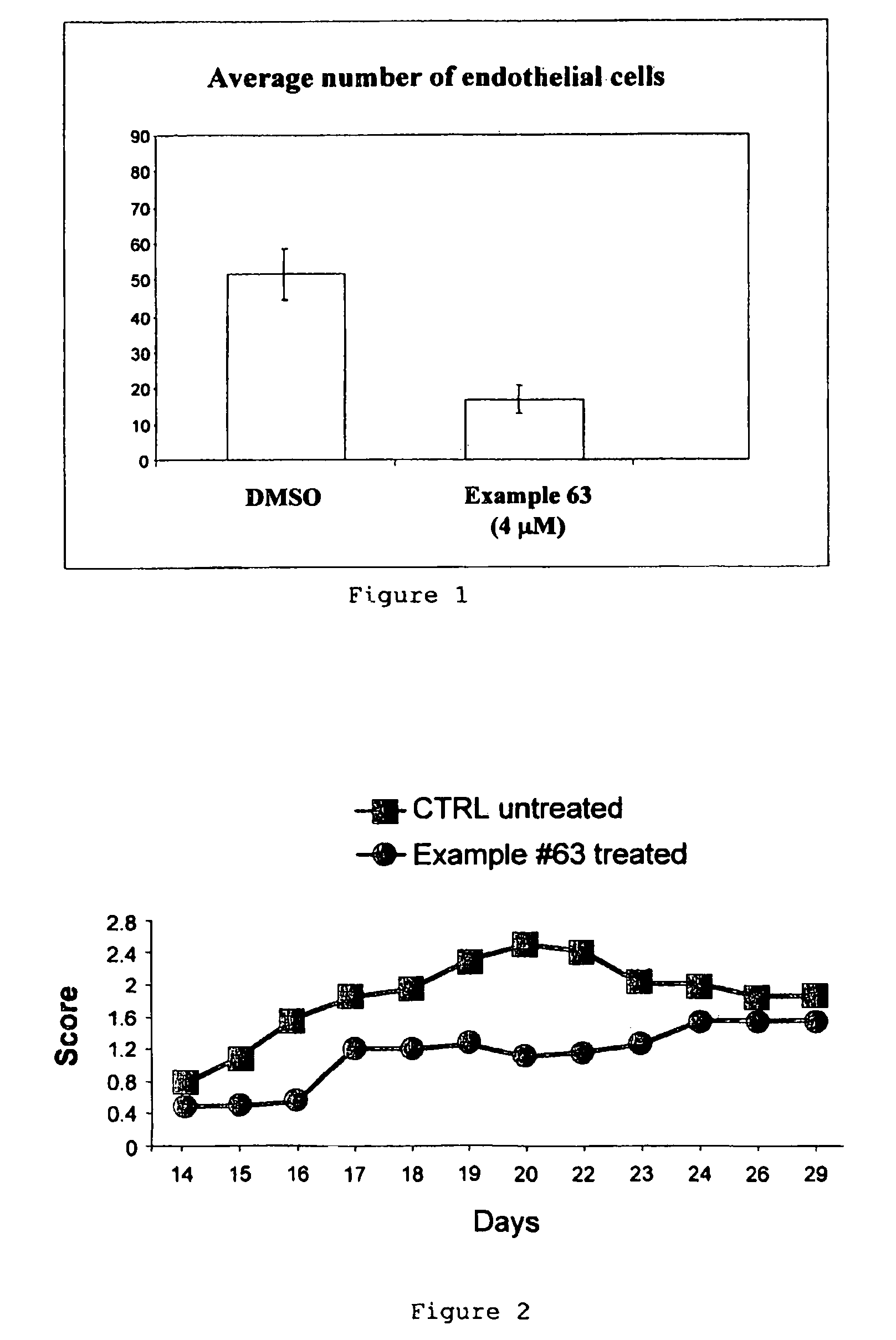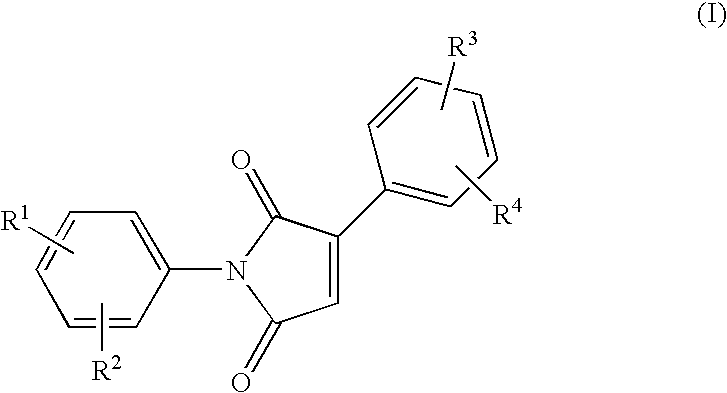Phenyl substituted maleimides as medicaments for blocking degenerative tissue damages by inhibiting MPT
a technology of phenyl substituted maleimides and medicaments, which is applied in the direction of biocide, drug composition, metabolic disorder, etc., can solve the problems of abnormal retinal vessel growth, osmotic swelling, and increased apoptosis ra
- Summary
- Abstract
- Description
- Claims
- Application Information
AI Technical Summary
Benefits of technology
Problems solved by technology
Method used
Image
Examples
example 1
1-(3-chlorophenyl)-3-(3-methylphenyl)-pyrrole-2,5-dione
[0099]
Step A: potassium 3-cyano-3-(3-methylphenyl)-acrylate
[0100]To a stirred solution of (3-methylphenyl)-acetonitrile (21.6 ml, 165 mmol) in methanol (500 ml) were added glyoxylic acid hydrate (22.7 g, 247 mmol) and potassium carbonate (57.0 g, 412 mmol). The reaction mixture was stirred at room temperature for 2 hours followed by 3 hours at reflux. The precipitate was filtered off, washed with methanol (300 ml), dichloromethane (DCM) (300 ml) and then dried under air suction. The desired product was obtained as a white solid which was used in the next step without further purification.
[0101]Yield: 43 g
[0102]Mass spectrum (ES-MS (+ve)) 188 [M(free acid)+H]+, Retention time 1.82 min, 100% UV.
[0103]1H-NMR (d6-DMSO, 400 MHz) δ (ppm): 7.45-7.32 (2H, m), 7.30 (1H, t), 7.15 (1H, d), 7.05 (1H, s), 2.29 (3H, s).
Step B: (3-methylphenyl)-furan-2,5-dione
[0104]A suspension of potassium 3-cyano-3-(3-methylphenyl)-acrylate (0.69 g, 3 mmol),...
example 2
1-(3-chlorophenyl)-3-(4-fluorophenyl)-pyrrole-2,5-dione
Step A: potassium 3-cyano-3-(4-fluorophenyl)acrylate
[0112]The reaction was carried out at room temperature for 3 hours.
[0113]Yield: 2.2 g (38%)
[0114]Mass spectrum (ES-MS (+ve)) 192 [M(free acid)+H]+, Retention time 1.72 min, 100% UV.
[0115]1H-NMR (d6-DMSO, 400 MHz) δ (ppm): 7.69-7.60 (2H, m), 7.32-7.22 (2H, m), 7.03 (1H, s).
Step B: 3-(4-fluorophenyl)-furan-2,5-dione
[0116]1H-NMR (d6-DMSO, 400 MHz) δ (ppm): 8.38-8.21 (2H, m), 7.90 (1H, s), 7.68-7.52 (2H, m).
Step C: 1-(3-chlorophenyl)-3-(4-fluorophenyl)-pyrrole-2,5-dione
[0117]Yield: 200 mg (85%)
[0118]Mass spectrum (ES-MS (+ve)) 302 [M+H]+, Retention time 2.44 min, 100% UV.
[0119]1H-NMR (d6-DMSO, 400 MHz) δ (ppm): 8.13-8.00 (2H, m), 7.50-7.39 (3H, m and 1H, s), 7.38-7.28 (3H, m).
example 3
1-(3-chloro-4-fluorophenyl)-3-(4-fluorophenyl)-pyrrole-2,5-dione
[0120]Yield: 230 mg (92%)
[0121]Mass spectrum (ES-MS (+ve)) 320 [M+H]+, Retention time 2.52 min, 100% UV.
[0122]1H-NMR (d6-DMSO, 400 MHz) δ (ppm): 8.22-8.12 (2H, m), 7.75 (1H, d), 7.65 (1H, t), 7.53 (1H, s), 7.50-40 (3H, m).
PUM
| Property | Measurement | Unit |
|---|---|---|
| molecular mass | aaaaa | aaaaa |
| dual wavelength UV detector | aaaaa | aaaaa |
| pH | aaaaa | aaaaa |
Abstract
Description
Claims
Application Information
 Login to View More
Login to View More - R&D Engineer
- R&D Manager
- IP Professional
- Industry Leading Data Capabilities
- Powerful AI technology
- Patent DNA Extraction
Browse by: Latest US Patents, China's latest patents, Technical Efficacy Thesaurus, Application Domain, Technology Topic, Popular Technical Reports.
© 2024 PatSnap. All rights reserved.Legal|Privacy policy|Modern Slavery Act Transparency Statement|Sitemap|About US| Contact US: help@patsnap.com










